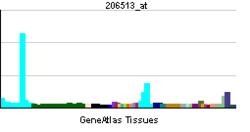AIM2
| View/Edit Human | View/Edit Mouse |
Interferon-inducible protein AIM2 also known as absent in melanoma 2 or simply AIM2 is a protein that in humans is encoded by the AIM2 gene.[3][4] Recent research has shown that AIM2 is part of the inflammasome and contributes to the defence against bacterial and viral DNA.[5]
Structure
AIM2 is a 343 amino acid protein with a N-terminal DAPIN (or pyrin) domain (amino acids 1-87) and a C-terminal HIN-200 domain (amino acids 138-337), which is known to have two oligonucleotide-binding folds.[6]
Function
AIM2 is a member of the Ifi202/IFI16 family. It plays a putative role in tumorigenic reversion and may control cell proliferation. Interferon-gamma induces expression of AIM2.[4]
Though there has been virtually no biochemistry performed, a model based on cell-based or in vivo experiments has led to the current model of how AIM2 triggers the inflammasome. The C-terminal HIN domain binds double stranded DNA (either viral, bacterial, or even host) and acts as a cytosolic dsDNA sensor. This leads to the oligomerization of the inflammasome complex. The N-terminal pyrin domain of AIM2 interacts with the pyrin domain of another protein ASC (or Apoptosis-associated Speck-like protein containing a caspase activation and recruitment domain). ASC also contains a CARD domain (caspase activation and recruitment domain), that recruits procaspase-1 to the complex. This leads to the autoactivation of caspase-1, an enzyme that processes proinflammatory cytokines (IL-1b and IL-18).[5]
Clinical relevance
Elevated levels of AIM2 expression are found in skin cells from people with psoriasis.[7]
References
- ↑ "Human PubMed Reference:".
- ↑ "Mouse PubMed Reference:".
- ↑ DeYoung KL, Ray ME, Su YA, Anzick SL, Johnstone RW, Trapani JA, Meltzer PS, Trent JM (Aug 1997). "Cloning a novel member of the human interferon-inducible gene family associated with control of tumorigenicity in a model of human melanoma". Oncogene. 15 (4): 453–7. doi:10.1038/sj.onc.1201206. PMID 9242382.
- 1 2 "Entrez Gene: AIM2 absent in melanoma 2".
- 1 2 Schroder K, Tschopp J (March 2010). "The inflammasomes". Cell. 140 (6): 821–32. doi:10.1016/j.cell.2010.01.040. PMID 20303873.
- ↑ Fernandes-Alnemri T, Yu JW, Datta P, Wu J, Alnemri ES (March 2009). "AIM2 activates the inflammasome and cell death in response to cytoplasmic DNA". Nature. 458 (7237): 509–13. doi:10.1038/nature07710. PMC 2862225
 . PMID 19158676.
. PMID 19158676. - ↑ Dombrowski Y, Peric M, Koglin S, Kammerbauer C, Göss C, Anz D, Simanski M, Gläser R, Harder J, Hornung V, Gallo RL, Ruzicka T, Besch R, Schauber J (May 11, 2011). "Cytosolic DNA triggers inflammasome activation in keratinocytes in psoriatic lesions". Sci Transl Med. 3 (82): 82ra38. doi:10.1126/scitranslmed.3002001. PMC 3235683
 . PMID 21562230.
. PMID 21562230.
External links
- Human AIM2 genome location and AIM2 gene details page in the UCSC Genome Browser.
Further reading
- Landolfo S, Gariglio M, Gribaudo G, Lembo D (1999). "The Ifi 200 genes: an emerging family of IFN-inducible genes". Biochimie. 80 (8-9): 721–8. doi:10.1016/S0300-9084(99)80025-X. PMID 9865494.
- Woerner SM, Kloor M, Schwitalle Y, Youmans H, von Knebel Doeberitz M, Gebert J, Dihlmann S (2007). "The putative tumor suppressor AIM2 is frequently affected by different genetic alterations in microsatellite unstable colon cancers". Genes Chromosomes Cancer. 46 (12): 1080–9. doi:10.1002/gcc.20493. PMID 17726700.
- Chen IF, Ou-Yang F, Hung JY, Liu JC, Wang H, Wang SC, Hou MF, Hortobagyi GN, Hung MC (2006). "AIM2 suppresses human breast cancer cell proliferation in vitro and mammary tumor growth in a mouse model". Mol. Cancer Ther. 5 (1): 1–7. doi:10.1158/1535-7163.MCT-05-0310. PMID 16432157.
- Cresswell KS, Clarke CJ, Jackson JT, Darcy PK, Trapani JA, Johnstone RW (2005). "Biochemical and growth regulatory activities of the HIN-200 family member and putative tumor suppressor protein, AIM2". Biochem. Biophys. Res. Commun. 326 (2): 417–24. doi:10.1016/j.bbrc.2004.11.048. PMID 15582594.
- Liu G, Yu JS, Zeng G, Yin D, Xie D, Black KL, Ying H (2004). "AIM-2: a novel tumor antigen is expressed and presented by human glioma cells". J. Immunother. 27 (3): 220–6. doi:10.1097/00002371-200405000-00006. PMID 15076139.
- Choubey D, Walter S, Geng Y, Xin H (2000). "Cytoplasmic localization of the interferon-inducible protein that is encoded by the AIM2 (absent in melanoma) gene from the 200-gene family". FEBS Lett. 474 (1): 38–42. doi:10.1016/S0014-5793(00)01571-4. PMID 10828447.
